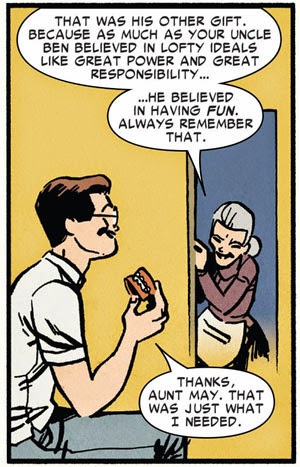
I think that if I were to fall into a time warp or wormhole and wind up somehow in
Manhattan in the mid 1960s, I'd skedaddle my little fuzzy bee-hind over to
655 Madison Avenue and get myself a job at
Marvel Comics! Every day I'd punch in and wave "hi" to the guys in the bullpen and settle down at my tiny desk to do my work. I'm not certain what I'd do, but I think
anything at Marvel comics in those days would have been a treat that I wouldn't have minded doing for
free! (Note to Martin Goodman: I'm not doing it for free.)
Maybe I could sharpen the pencils of
Jack Kirby, as well as occasionally modeling when he needs to get a pose just right for the ever-lovin' blue-eyed
Thing! Or I could be the guy who keeps the curtain raised up around
Steve Ditko so nobody would ever see what he really looked like, or if he was reading Ayn Rand on his lunch hour! I certainly would love to be a gopher to the lovely
Flo Steinberg, and I'd make sure that Stan gave her a big raise. Of course I wouldn't mind if I was the guy who got to run down Madison Avenue to Forty-Second Street and take the elevator up to the thirty-fifth floor of the
Baxter Building to deliver this month's
Fantastic Four comics to Ben, Johnny, Reed or even that dreamy Sue Storm. Golly.
No, you know what job I'd
really like to have on Marvel's titanic dozen and a half comics at the time (yes, even
Millie the Model!)? I think I'd like to write the
credits that appear on the first story page of every mildly magnificent Marvel mag of the month. Because when Stan, Jack, Steve & Co. built the Marvel Universe, they didn't just make their characters larger than life, they made
everything larger than life! (Seriously. You shoulda seen their
coffeemaker.) It was truly the Marvel Age of bombastic excitement and boisterous entertainment, and those credits at the front didn't
just tell you who wrote and drew and lettered the story, oh no—they were mini-Marvel epics of their own, different and dynamic every month. No mere "Script by Stan Lee, pencils by Jack Kirby" for
these guys. Again, oh no.
Shall we take a peek at some of the grandest and splendiferous credit sequences of mid-sixties Marvel Comics? Well, if we don't,
I've pretty much wasted this column up until this point, haven't I?
Frequently Stan's credits would be in the same ringmaster-voiced, energetic grand announcement tone of the Bullpen Bulletin's and Stan's Soapbox, telling you that the Marvel mag you held in your hooves was the greatest thing since sliced bread (but don't put peanut butter on it!):

Fantastic Four #50 (May 1966)
The credits took on the tone of a sideshow barker, with plenty of alliteration. No, it's not true that Stan Lee wrote the lyrics of "Being for the Benefit of Mister Kite!" by the Beatles...
but he could've!
Avengers #18 (July 1965)
A Marvel Comic, unlike those brittle and dry knock-offs over at Brand Ecch, promised only the most savory and juicy of comic stories. No wonder in the 60s,
choosy mothers chose Marvel!
Avengers #23 (December 1965)
Monty Python and Zucker, Abrahams and Zucker would later bring the gag credit insert to the screen both big and small, but here's Stan doin' it—a gag credit, that is—on the splash page of FF #53:

Fantastic Four #53 (August 1966)
In fact, you might say Marvel credit boxes went that
X-tra mile to
X-cite us and
X-ault us and okay I'll stop.

[Uncanny] X-Men #11 (May 1965)
But by far the most common credit joke in a Marvel mag (hey, that rhymes!) is the same rhythm that years before Beethoven had invented: da da da DAHHH: a one, two, three, and then the
four-punch: a gag targeting the fourth line of the credits: usually letterer Sam Rosen...

Sgt. Fury #19 (June 1965)
Or letterer Artie Simek:

Fantastic Four #48 (March 1966)
Even a
three-line credit (caused by a single penciller/inker) had a lyrical rhythm of its own, complete with a jab at the letterer.

Amazing Spider-Man #29 (October 1965)
As Marvel's go-to guy for lettering, it was Artie Simek who usually came in as the punchline of a credit box gag, whether it be a gentle ribbing...

Avengers #13 (February 1965)
...or a punchline that brought the mock-grandeur and glory down to earth with a guffaw...

Journey Into Mystery #120 (September 1965)
Artie frequently served as the Ringo to the other creators...

Sgt. Fury #14 (January 1965)
But even if you're tempted to write into the Bullpen and declare 'Hey, quit pickin' on Artie!'...

Avengers #21 (October 1965)
...never forget it was
Artie Simek himself who lettered the gags in the first place!

[Uncanny] X-Men #14 (November 1965)
And, as the saying goes in Comics World...the one person you ought not to tick off is the letterer, because he
always has the final word!

Avengers #19 (August 1965)
After a while, the Artie Simek credit references almost came to be a meta-joke in and of themselves:

Journey Into Mystery #119 (August 1965)
I'd imagine if FF #41 was your first Marvel comic, you wouldn't know
what the heck this credit box as referring to!

Fantastic Four #41 (August 1965)
Even when the usual sequence of credits got tweaked, Sneaky Stan usually came out as the big man:

Amazing Spider-Man #20 (January 1965)
But occasionally even long-sufferin' Simek got his revenge. Sort of.

Amazing Spider-Man #22 (March 1965)
Still, fun as they were, you didn't read the books for the credits, but for the high adventure escapades of superheroes battling against incredible odds versus dastardly villains in amazing landscapes. So even
Stan knew—once in a while—to just shut up and get on with the story:

Fantastic Four #56 (November 1966)
Nuff said, indeed, Stan. Excelsior!
